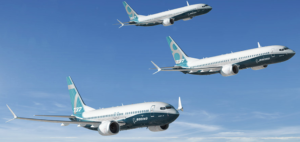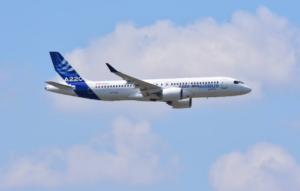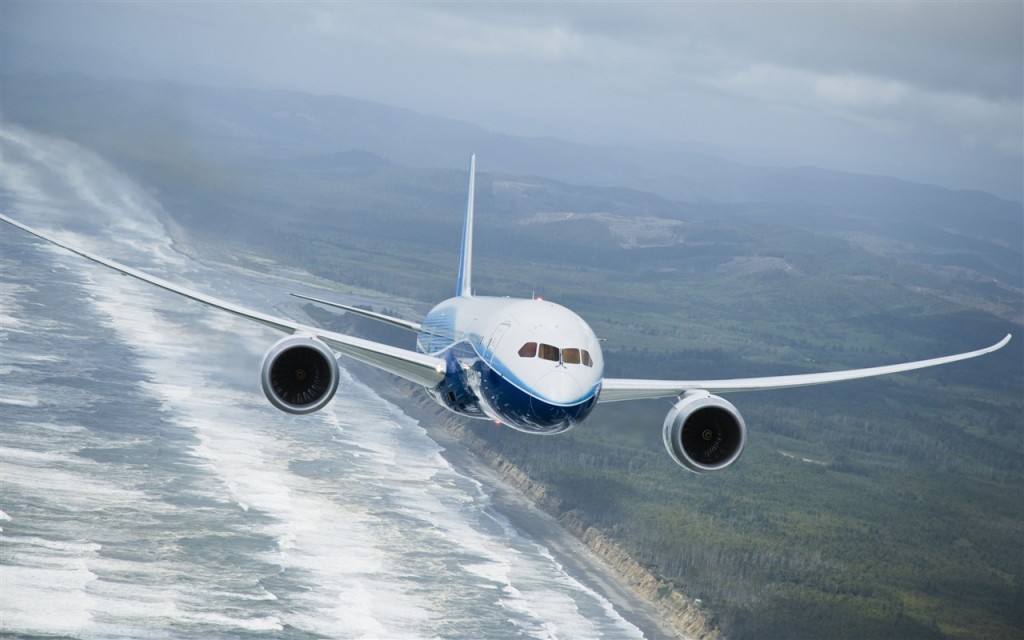Leeham News and Analysis
There's more to real news than a news release.
Boeing 737 MAX 2020-23 backlog will require to 2026 to deliver: analysis
Subscription Required
Introduction
By Scott Hamilton
Feb. 14, 2020, © Leeham News: It will take Boeing years to deliver new production airplanes scheduled for delivery in 2020-2023 because the restart of the 737 MAX production will fall far short of delivery commitments.
There are an estimated 2,682 deliveries scheduled in this timeframe. Boeing’s production restart and ramp up provides delivery positions for an estimated 1,827 aircraft. This leaves an estimated 855 aircraft that will have to be rescheduled into the future, from 2023.
These will compete with Boeing sales for new order delivery slots. For example, the MOU for 200 MAXes from IAG, the parent of British Airways and other carriers, has delivery slots in these periods.
An analysis by LNA indicates it will take at least until 2026 to deliver these 855 airplane if no other orders are slotted in through 2025.
Assessing airlines’ widebody replacement needs
Subscription Required
By Vincent Valery
Introduction
Feb. 3, 2020, © Leeham News: As part of the 777X maiden flight, Boeing briefed the media on its demand forecast for the large widebody market. The OEM sees a demand to replace between 60 and 100 aircraft annually in that market segment until 2030.
Last week we estimated the number of narrowbody aircraft where airlines still need to place a replacement order. We now perform a similar analysis for the widebody market.
OEMs are struggling to cope with the insatiable demand for latest-generation narrowbody aircraft. However, the situation is different in the widebody market. After significant orders and deliveries during most of the last decade, demand is sharply slowing now.
After announcing a 787 Dreamliner production rate cut last year from 14 to 12 per month, Boeing acknowledged it is expecting a further cut to 10 per month from early 2021. The company expects to return to rate 12 in 2023.
Airbus hasn’t announced any reduction in its A330neo or A350 production rates yet but acknowledged demand softness.
Both OEMs point to the significant widebody replacement needs that will arise later in the decade. We will analyze whether their hope for better days is justified.
We will also partially address why Boeing decided to go back to the drawing board on new aircraft design.
Summary
- At face value, numerous widebody aircraft to replace;
- Materially different customer mix from narrowbody aircraft;
- Varying demand, depending on aircraft size;
- Boeing forecast for the large widebody market;
- And a change of mind on the NMA;
- Replacement needs timelines.
With Boeing’s 737 MAX delivered to storage instead of customers, unique cost and revenue insights can be gained, Part 2.
By Bjorn Fehrm
Subscription Required
Introduction
January 30, 2020, © Leeham News: The last three-quarters of non-delivered Boeing 737 MAX production has exposed the internals of an airliner OEM as never before.
By comparing the second, third and fourth quarterly reports from Boeing for 2018 and 2019 we can get an understanding of the net revenue shortfall for the non-delivery of 737 MAX aircraft during 2019. By digging deeper into the reports we can also get an understanding of the present production cost of the 737 MAX.
Summary:
- The difference in revenue for a well-chosen time period of 2019 compared to the same period in 2018 tell the story of 737 MAX net revenue per aircraft.
- In principle, the same is valid for production costs which get booked into inventory instead of being delivered. Here more intricate adjustments must be made, however.
Assessing airlines’ narrowbody replacement needs
Subscription Required
By Vincent Valery
Introduction
Jan. 27, 2020, © Leeham News: The Boeing 737 MAX crisis appears headed for resolution within a few months.
Stephen Dickson, the administrator of the Federal Aviation Administration, told American, Southwest and United airlines the MAX could be recertified by summer. This is the first time the FAA suggested a timeline—though anything could change this.
However, the entire commercial airline ecosystem has even less visibility on another key topic: once the 737 MAX returns to service, will airlines and lessors place new orders for what was Boeing’s best-ever selling aircraft?
Whether the 737 MAX can accumulate a meaningful amount of new orders will have far-reaching consequences on Boeing’s finances and product strategy. As outlined in a previous LNA article, it might take until 2022 at the earliest to return to the intended production rate (57/mo) before the grounding.
Even if not many airlines cancel their 737 MAX orders, Boeing will need to accumulate sizable new orders to keep the assembly line busy through the 2020s. Any clean-sheet aircraft design would only be ready in the late 2020s at the earliest. Boeing CEO Dave Calhoun expressed confidence in regaining the market share Boeing had before the grounding.
Is Calhoun’s optimism justified?
The most reliable market to accumulate new orders is the replacement of aging aircraft. In this article, we come up with a conservative estimate of the number of aircraft airlines still need to order or lease to replace older airframes. We will analyze the breakdown among customer types, as well as timelines.
Summary
- A significant number of aging narrowbody aircraft to replace;
- Different order and replacement mix at Airbus and Boeing;
- And airline fleet types;
- Concentrated order and replacement opportunities;
- Replacement needs timelines.
With Boeing’s 737 MAX delivered to storage instead of customers, unique cost and revenue insights can be gained.
By Bjorn Fehrm
Subscription Required
Introduction
January 23, 2020, © Leeham News: The last three-quarters of non-delivered Boeing 737 MAX production exposes the internals of an airliner OEM as seldom before.
The second, third and eventually fourth quarterly reports from Boeing can be compared to the same reports for the 2018 quarters. The differences in the numbers represent the production cost of the 737 MAX being booked as inventory instead of revenue. These values make for interesting reading as they give deeper insights into the production costs and net customer prices for the model.
Summary:
- When the MAX goes to storage it’s delivered to Boeing Commercial Airlane’s inventory.
- The net production cost appears in an increased inventory cost and the net customer price is missing in revenue.
- By careful comparison of the quarterly reports between 2019 and 2018, cost and revenue insights can be gained
Environment and aviation, a gap between aspirations and reality
Subscription Required
By Vincent Valery
Introduction
Jan. 20, 2020, © Leeham News: Talks about climate change and the need to reduce human-induced carbon emissions are nowadays a daily occurrence in Western media. After years of faster-than-trend growth in global passenger numbers, aviation-induced carbon emissions commensurably increased in spite of record deliveries in latest-generation, fuel-efficient planes.
As a result of this growth, airlines have been one of the main targets of environmental groups. The high growth culminated in the start of the flight-shame movement that originated in Sweden (flygskam). As outlined in a previous LNA article, there are discussions about introducing a jet fuel tax for all flights within the European Union.
Airbus is committed to the “decarbonization” of its next airplane design.
Boeing’s next move for a new airplane has been sidetracked by the 737 MAX crisis.
Embraer is devoting considerable effort to developing a “green” airplane.
Summary
- Airlines and politicians on the back foot;
- Variety of opinion among regions;
- And airlines make consensus-building hard;
- An obsession with one way to reduce emissions;
- Flybe’s bailout summarizes contradictions and challenges.
How far can Boeing’s remaining cash cow, the 787, pay the company bills, Part 2?
By Bjorn Fehrm
Subscription Required
Introduction
January 16, 2020, © Leeham News: Last week we started the analysis of how much margin the Boeing 787 program is generating to cover the costs for The Boeing Company’s Commercial Airplanes division when the other cash cow, the 737 MAX program, brings no revenue or margin.
The 787 program is now in a state where it generates significant revenue and margin. The other programs, the 767 and 747 freighters, the 737NG (P-8A Poseidon) and 777 Classic make up less than 45% of deliveries with the 787 covering 55% of deliveries, and these programs are in phases where they deliver less margin.
Summary:
- The 787 program accounting employs different accounting block production costs for the different 787 variants.
- The 787-10 carries the highest accounting block cost and is accordingly the most important variant for the payback of the deferred costs.
- The 787-8, despite leading the program, generated the largest deferred costs (due to learning curve effects), amortizes the least of the variants.
Read more






